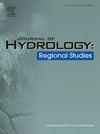Improving trans-regional hydrological modelling by combining LSTM with big hydrological data
IF 4.7
2区 地球科学
Q1 WATER RESOURCES
引用次数: 0
Abstract
Study region
Lancang-Mekong River Basin (LMRB), Brazil.
Study focus
Streamflow prediction in ungauged basins is a significant challenge in hydrology. This study investigates the transferability of deep learning models for hydrological simulations in ungauged basins, focusing on how constraints like catchment attributes, meteorological forcing, and Global Hydrological Models (GHMs) improve model performance when transferring knowledge from gauged to ungauged basins. We applied the Catchment Attributes and Meteorology for Large-sample Studies (CAMELS-BR) dataset alongside GHMs and deep learning techniques to simulate hydrological processes in the LMRB.
New hydrological insights for the region
The results demonstrate that a post-processing scheme combining deep learning, meteorological data, and GHMs significantly improves model accuracy, achieving a median Nash-Sutcliffe Efficiency (NSE) of 0.64, compared to 0.50 for the baseline Long Short-Term Memory (LSTM) model without GHMs. Key factors influencing model performance include catchment attributes, climate variations, and the length of the modelling series. A notable finding is the importance of catchment attributes in defining hydrological similarity, which enhances model migration between regions with differing data availability. Cross-regional migration was particularly successful when hydrological similarities between the Amazon Basin and LMRB were evaluated, achieving an NSE of 0.86 at the Pakse hydrological station. These insights provide a novel modelling framework for hydrological simulations in data-scarce regions, emphasizing the role of physical mechanisms and hydrological similarities in improving model transferability.
求助全文
约1分钟内获得全文
求助全文
来源期刊

Journal of Hydrology-Regional Studies
Earth and Planetary Sciences-Earth and Planetary Sciences (miscellaneous)
CiteScore
6.70
自引率
8.50%
发文量
284
审稿时长
60 days
期刊介绍:
Journal of Hydrology: Regional Studies publishes original research papers enhancing the science of hydrology and aiming at region-specific problems, past and future conditions, analysis, review and solutions. The journal particularly welcomes research papers that deliver new insights into region-specific hydrological processes and responses to changing conditions, as well as contributions that incorporate interdisciplinarity and translational science.
 求助内容:
求助内容: 应助结果提醒方式:
应助结果提醒方式:


